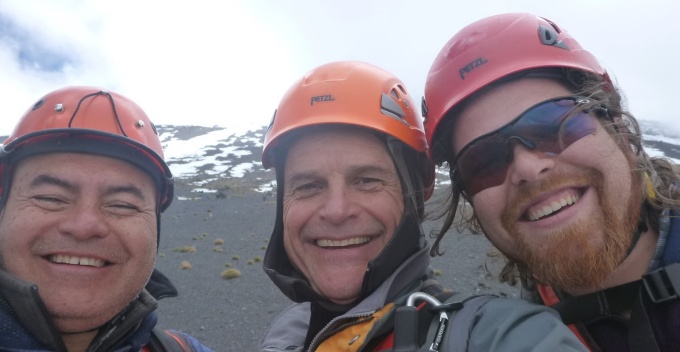Geohazards, Volcanoes and Geodynamics

The Geohazards, Volcanoes and Geodynamics Group at UB is a vibrant community of researchers dedicated to understanding Earth's dynamic systems. The group focuses on fundamental research and teaching across all aspects of physical volcanology with a commitment to advancing knowledge about volcanic processes, geohazards and the forces shaping the Earth's interior. Through fieldwork, laboratory studies and computational modeling, the group aims to deepen our understanding of volcanic systems and contribute to global efforts to mitigate geohazards.
The Geohazards, Volcanoes, and Geodynamics Group is currently composed of four faculty, one research scientist, two postdoctoral researchers and typically 20 to 30 graduate students.
- Bea Csatho - (Professor) Remote Sensing, Glaciology, Climate Change, Geophysics
- Tracy K. P. Gregg (Associate Professor) – Planetary volcanology (particularly on Mars and the Moon), mid-ocean ridge volcanism, basaltic lava flows
- Margarete Jadamec (Associate Professor) - Geodynamics, Tectonophysics, High Performance Computing
- Stephan Kolzenburg - (Assistant Professor) Volcanology, igneous petrology, and geological materials science using experimental, field, and remote sensing methods
- Ingo Sonder – (Research Scientist) - Experimental volcanology, magma-water interaction, explosion dynamics
- Greg A. Valentine (Professor) – Volcanic risk, basaltic volcanic fields, pyroclastic deposits, volcano fluid dynamics, volcaniclastic and surface processes

We share a broad focus on geological hazards, volcanic processes, and geodynamics. Areas of research include plate tectonics, subduction zones, mountain building, and high-resolution data-driven modeling of natural tectonic plate boundaries, volcanic flows, compaction-cooling processes, slope stability, geological mass flows, volcano deformation, volcano plumbing, explosive eruptions, magma-water interaction, mid-ocean ridge volcanism, volcano-tectonics, seismic hazard and crustal faulting processes (seismic and aseismic), aquifers-related deformation, environmental hazards, and resources sustainability.
The group's work links strongly with efforts coordinated by the university-wide Center for Geological and Climate Hazards,
which works to nucleate and facilitate cross-disciplinary efforts to understand and mitigate geological hazards. Recent work in this area includes probabilistic assessments of future eruptions in volcanic fields, and stochastic eruption plume and pyroclastic flow modeling. An additional major effort is development of the Geohazards Field Station, an outdoor lab for large-scale experiments on geological hazards processes.
- Emplacement of volcanic flows (including field, experimental and computational studies related to emplacement of debris avalanches, pyroclastic flows and debris flows).
- Eruption column dynamics (including eruption column modeling and tephrochronology)
- Phreatomagmatic eruptions (including surface and subsurface effects of magma-water explosions and fundamental physics of magma-water interaction)
- Basaltic volcanism (including conduit processes, magmatic plumbing, magma recharge, mid-ocean ridge volcanism, lava-flow emplacement and basaltic field volcanism). Extraterrestrial volcanism (including mapping of volcanic landforms and modeling volcanic processes on the Moon, Mars and Venus).
- Coupling between volcanism and tectonism ( including volcanism in extensional environments, and volcanism in the Andes)
- Subduction dynamics (including slab-driven mantle flow dynamics, dynamic feedbacks between the subducting and overriding plates, lithosphere-asthenosphere coupling in subduction zones, 3D numerical modeling of natural subduction systems)
- computational fluid dynamics of non-linear flow systems (including large-scale numerical simulations of non-linear mantle dynamics, computational challenges of modeling non-linear Earth systems, software for complex model design, leveraging 3D virtual reality for complex systems)
- lithosphere deformation (including tectonic deformation at convergent and divergent plate boundaries, coupling of multi-plate systems in regions of oblique convergence, long-term mechanisms for mountain building, plate boundary tectonics)

Our program offers PhD, MS, MS-non thesis and Computational Earth Science MS degrees. along with a specialized Professional Science Master’s (PSM) in Geohazards. Our program combines cutting-edge research, hands-on fieldwork, and expert faculty guidance to help students understand the dynamic forces shaping our planet.
Our program is designed to prepare students for careers in research, industry, and academia.
- Undergraduates gain foundational knowledge in geohazards, volcanoes, and geodynamics, learning the methods and principles of the field.
- Master’s students develop expertise through coursework and a guided research project, gaining skills that make them competitive in the job market.
- PhD students receive close mentorship, master technical skills, and contribute to the field through scholarly publications.